There are two specific core memories I have from my teaching career when I needed syllable type instruction to help my students with decoding multisyllabic words…and I didn’t know it.
- During my first teaching observation, I presented a student with the word “udder.” He said he couldn’t read it because it had two ds. I had no idea what to do to guide him. Now, I know I needed syllable instruction.
- During my fifth year of teaching, I had 11 students reading on a 1st/2nd grade level in 5th grade. I administered basic phonics assessments, and they knew all of their sounds. I was stumped. I remember asking the 1st grade teachers and the literacy coach for strategies or even books I could read to learn how to help them. I didn’t know it then, but teaching syllable types as a strategy for decoding multisyllabic words would have been the perfect first step.
Why Teach Syllable Types?
Reason 1: Gives students a strategy for all the vowel sounds.
Consonants are pretty easy for students to figure out, but the trickiest sounds in English are definitely the vowels. Students need a strategy to help them determine what sounds the vowels make in words. If students understand the syllable type, they will have a better understanding of whether a vowel is going to be short, long, or work with another vowel or letter (vowel team, r-controlled, or silent e, for example).
Reason 2: Teaching through syllables is a “mature” way to reteach necessary phonics to struggling older readers.
Students know when they are behind and can be discouraged by doing “babyish” phonics work. Using syllable types and patterns to reteach phonics is a great way to reach those older students and engage them in necessary phonics skills.
Reason 3: Gives students a strategy to decode longer words using their known phonics skills.
Teaching students the syllable types will help them access longer words and apply the phonics skills they learned in the primary grades to those words. Many students skip words or mumble when presented with larger words. Teaching them a systematic way of breaking words into decodable syllables will help them build their skills and confidence.
Reason 4: Helps students begin to recognize chunks and patterns between known and unknown words.
The purpose of teaching students syllable types is not to require students to identify the types or even necessarily label them (although that is great in the beginning) but to know how to pronounce those chunks and patterns as they see them in words they are reading. This will help them begin to orthographically map word patterns and chunks and connect them to unknown words as they are reading.
A Word of Caution when Teaching Syllables
Syllable types are not an exact science. There are always exceptions. However, when you are first introducing a syllable type to your students, it is important to use words that follow the type you are teaching. Try to avoid using exception words when first teaching a type.
Also, some students only need a brief introduction and practice with syllable types. Others need more explicit, systematic instruction. The goal is to have students eventually move to automaticity with reading multisyllabic words, and the time and support it takes will vary.
Finally, for a student to successfully decode a word, the word has to be in their speaking and listening vocabulary. This will allow them to self-correct and flex the sounds to get to the correct pronunciation.
What are the Syllable Types?
There are six to seven syllable types, depending on which program you use. These syllable types are based on phonics patterns used in the majority of the words in the English language.
- Closed Syllables
- Open Syllables
- Silent E Syllables
- Vowel Team Syllables
- R-Controlled Syllables
- Consonant + le Syllable
A 7th type would be a diphthong. Some programs split up vowel teams and diphthongs. Also, some programs teach Consonant + le as a Final Stable Syllable (the umbrella type) and include other syllables such as -tion and -ture.
Let’s Look Closely at Each Syllable Type with Examples:
Closed Syllables
A closed syllable has a vowel followed by a consonant. Consonants can “close in” the vowel (win) or follow the vowel (in). The vowel usually makes the short vowel sound.
Examples:
bus, him, shed – all closed syllable 1-syllable words
rab/bit and mit/ten – both syllables closed
mag/net/ic and vol/can/ic – three closed syllables
Open Syllables
An open syllable ends with a single vowel. The vowel is “open and free.” The vowel usually makes a long vowel sound.
Examples:
go, so, no – all open syllable 1-syllable words
ex/po – first syllable closed, second syllable open
o/pen – first syllable open, second syllable closed
Silent E/Magic E Syllables (VCe)
The silent e syllable uses a VCe (vowel – consonant – e) pattern. The e is silent. It usually makes the other vowel have a long sound.
hope, save, gene – all silent e syllable 1-syllable words
es/cape – first syllable closed, second syllable silent e
pri/mate – first syllable open, second syllable silent e
life/less – first syllable silent e, second syllable closed
Vowel Team Syllables
A vowel team syllable is when letters work together or make a team to form one vowel sound.
boat, great, rain – all vowel team syllable 1-syllable words
pay/check – first syllable vowel team, second syllable closed
coast/line – first syllable vowel team, second syllable silent e
Diphthong Vowel Team Syllables
A diphthong syllable is a specific type of vowel team that forms a new vowel sound that is not long or short.
soup, new, drool – all diphthong vowel team syllable 1-syllable words
ig/loo – first syllable closed, second syllable diphthong
sham/poo – first syllable closed, second syllable diphthong
au/thor – first syllable diphthong, second syllable r-controlled
R-Controlled Syllables (V + r)
An r-controlled syllable has a vowel followed by an “r”. The “r” controls the vowel and changes the sound it makes.
germ, barn, bird – all r-controlled syllable 1-syllable words
part/ner – both syllables r-controlled
hi/ber/nate – first syllable open, second syllable r-controlled syllable, third syllable silent e
Consonant + le (C + le)
A C + le syllable has a consonant followed by “le.” The final “e” is silent. It creates a schwa sound (uh) which makes the “le” sound like “ul.”
C + le syllables are not found in one syllable words.
bum/ble – first syllable closed, second syllable C + le
sta/ple – first syllable open, second syllable C + le
can/dle/stick- first syllable closed, second syllable C + le, third syllable closed
Key Understandings Students Need Before Teaching Syllable Types:
Here are some important understandings that students need to know before teaching the syllable types:
- Students need to know what syllables are and how to determine how many there are in spoken words.
- Students need to know that every syllable includes only one vowel sound.
- Students need to know that a syllable can have multiple vowel letters that work together or with consonants to produce one vowel sound.
- Make sure students understand and know the language of instruction. They need to understand and be able to identify consonants, vowels, short sounds, and long sounds.
- Students need a basic understanding of how to divide words into syllables. Some programs use specific syllable patterns to teach students to break words into syllables. However, in order to lighten students’ mental load, a more flexible strategy is often used in the upper elementary grades.
- Find the vowels. Are they together, apart, or working with a consonant letter?
- Use the vowels to help you divide the word into syllables.
- Read the word syllable by syllable…blending the syllables into the next as you read without pausing or stopping.
- Repeat the word and “flex” the sounds as needed. Ask: Does this sound like a word I know?
Note: With students who struggle, you will need to explicitly teach students how to flex consonants and vowel sounds and to be flexible when decoding words. Flexing means being flexible and knowing that letters can and do make different sounds. Flexing a sound is trying out another sound the letter(s) make or even replacing a vowel with a schwa sound.
What About Schwa?
A schwa is a vowel sound in an unstressed syllable. It is commonly pronounced with the “uh” sound. It is important to understand the schwa sound because it causes there to be some exceptions to syllable types.
Banana (ba/nan/a) is pronounced buh/nan/uh. The first and last syllables do not follow the open syllable rules. They make the “uh” sound, which is the schwa.
Bottom (bot/tom) reads as bot/tuhm. The o is an unaccented syllable and does not follow the closed syllable rule. The “o” makes the “uh” sound, making it the schwa.
Sequence and Steps to Teaching Syllable Types
1. Review the basics of syllables with your students. Practice counting syllables in spoken words if needed.
2. Explicitly teach each syllable type in a systematic sequence where they build on one another. Here is the sequence I recommend:
-
- Closed Syllables
- Open Syllables
- Silent E Syllable (VCe)
- Vowel Teams (and Diphthongs) – I like to separate these out and teach predictable vowel teams, unpredictable vowel teams, and diphthongs. Students often struggle with all the vowel sounds, so splitting them into chunks (and then reviewing) helps.
- R-Controlled (V+R)
- Consonant + le
This may take days, weeks, or even go into a couple of months with some students. Regular monitoring and informal assessment is key to ensuring students have mastered a syllable type before moving on to others.
3. When introducing a new syllable type, review the previously learned types and build on from those. Include words in your instruction that not only introduce the new type in its purest form (no schwa or exceptions) but also include the other syllable types. This ensures the instruction is both systematic and cumulative.
4. Model how to find and read the syllable types in words that don’t fit the pattern and/or words that contain the schwa. Even though we want to use pure examples during initial instruction, the reality is that the words students see in reading will not always be pure examples. Modeling how to use the syllable types with these words will help bridge the gap from instruction to practice. Make sure students understand that the final word may be an approximation of its syllables. This is because unaccented syllables typically make the schwa sound.
5. Continue reviewing the syllable types in authentic text.
-
- Pull out the multisyllabic words from stories that students are about to read. Scoop the syllables and discuss the syllable types.
- When students are reading, remind them to look for known syllable types to help them decode the words.
- Remember to scaffold the supports – take away supports when you are able as the main goal is to have the students visually breaking apart and analyzing words as they are reading.
Next Steps After Syllable Type Instruction
The next steps after students have mastered syllable type instruction could be:
- Morphology Instruction – Morphology is a great way to connect decoding skills with vocabulary and making meaning. Since affixes are also syllables, being familiar with affixes and how to identify them can help students when reading multisyllabic words. Click here to read a post with more details about teaching morphology in grades 4-5!
- Flexing Sounds – Increase students practice with flexing sounds as they are reading. Flexing from short to long vowel sounds, flexing vowel team sounds, and flexing vowels to the schwa sound.
- Vocabulary Knowledge – Continue increasing students’ speaking and listening vocabulary so they will have better success at decoding multisyllabic words and tweaking the pronunciation to fit known words.
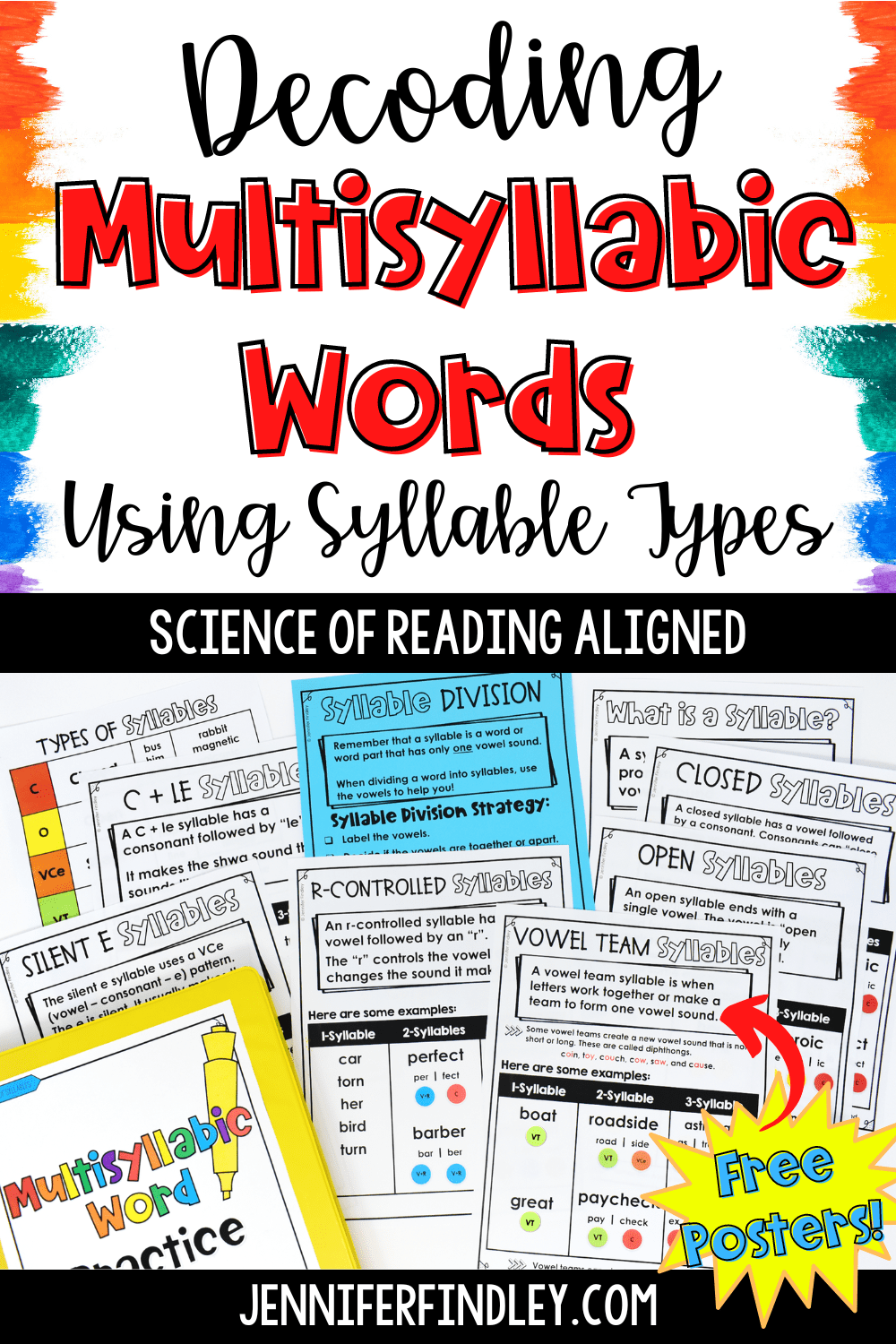
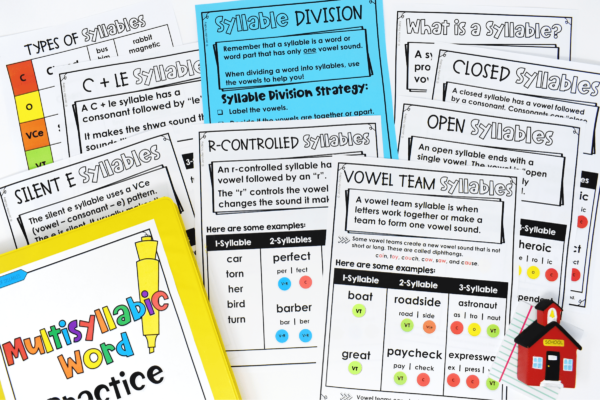
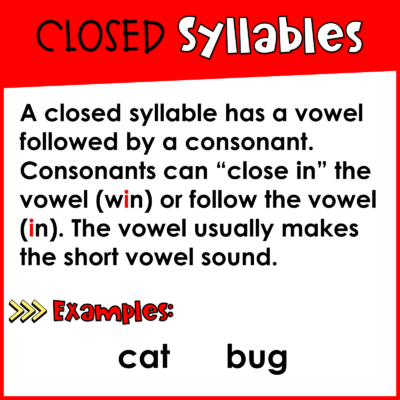
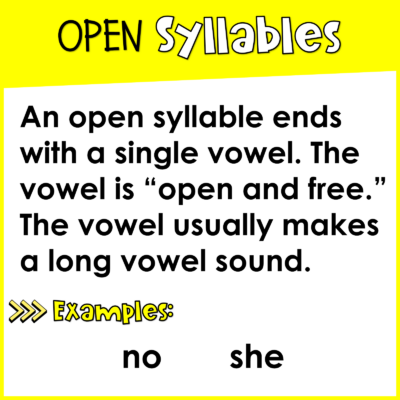

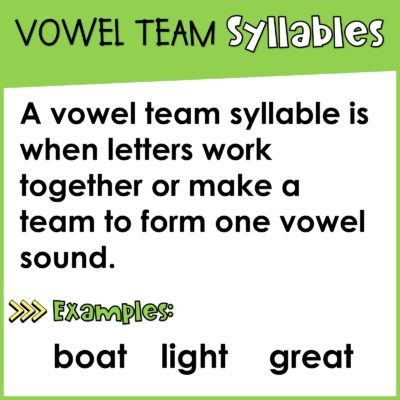
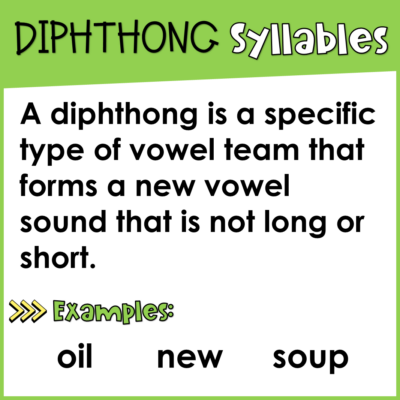
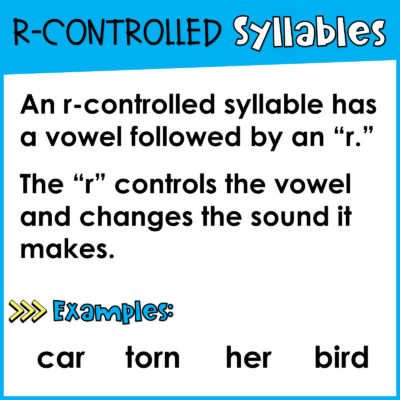


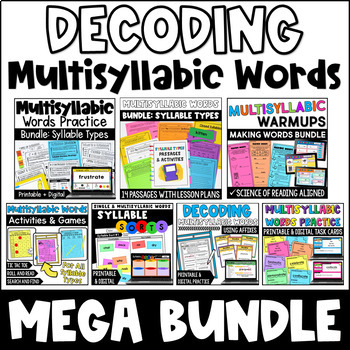







This is the best explanation of teaching reading with syllables that I have come across – brilliant! Thank-you for sharing 🙂
This is Absolutely Awesome!! Thank you so much for making this available!! I am Homeschooling my daughter (Kindergarten) and my Son (5th grade). This is a lifesaver and helps in more ways than you realize!!!
I’m very excited to start using this in my classroom! How do you assess students on decoding multisyllabic words? Thanks!
love this!!
Jennifer I just want to thank you for all of your wonderful resources through the years! It is my 34th and last year and I wanted to let you know how much it meant to me to have intelligent, fun, and practical resources at my fingertips. You are a master educator!